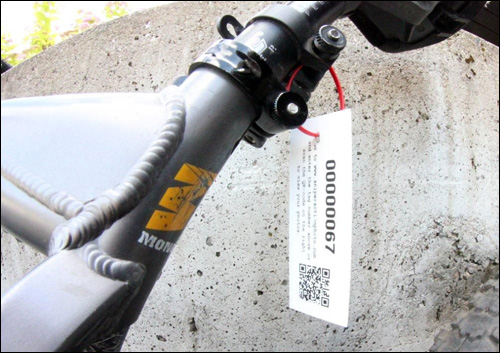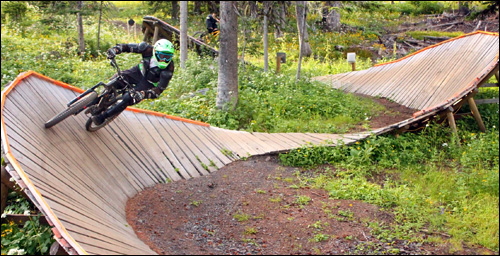RFID Pairs Action Photos With Mountain Bikers
Several resorts are using a wireless solar-powered system that can automatically take action shots, enabling visitors to view and purchase images of themselves online.
When mountain bikers zoomed by key points last summer during their rush to the bottom of the hill at the Silver Star Mountain Resort, in British Columbia, they also passed RFID antennas that captured the ID number of a tag attached to each bike. A camera then began snapping pictures, based on a motion sensor, and those action shots were paired to the individual for him or her to view online. The installation was a test of British Columbian start-up Sniper Action Photo’s automated photography system that utilizes a motion detector to trigger the snapping of pictures, as well as radio frequency identification technology to match each photo with a particular biker. The technology will be installed this summer at Silver Star, as well as at several zipline parks, at sites where there are a large number of participants.
Mountain Pass Systems, a ski-industry RFID solutions developer based in New York, provided RFID hardware and expertise, while the RFID-based software was supplied byTranscends.
At Silver Star Mountain Resort, RFID-enabled cameras are installed at fo
Sniper Action Photo was launched to provide action pictures for mountain bikers, a sector of athletes that can be difficult to photograph. The company’s cofounder and operations manager, David Grimsdell—a mountain biker himself—had been seeking a technology-based solution that resorts and bike parks could employ to offer photos to their patrons, without requiring that photographers be stationed on the hill. The company developed a camera linked to a motion sensor, but it still required a way to pair the images with the proper rider. For that purpose, Grimsdell says, the company developed a solar-poweredRFID-based solution using Motorola FX7400 readers, Alien Technology ALN-9640 SquiggleGen 2 passive UHF RFID tags made with Alien’s Higgs 3 RFID chips, and a computer processor running Transcend’s Rifidi middleware, as well as software designed by Sniper Action Photo.
 Sniper Action Photo’s David Grimsdell
Sniper Action Photo’s David Grimsdell
For the pilot, bikers at the lift entrance were offered an opportunity to have their pictures taken. Each biker who accepted was provided with an RFID tag with a unique ID number encoded to it that could be attached to his or her seat post via a zip tie. The bike and rider were then transported to the top of the trail, to begin the journey to the bottom of the hill. An RFID reader was installed at four key locations. As the bike passed a reader, its tag ID number was captured. Shortly thereafter, the bike came into range of the motion sensor, which triggered the camera to begin shooting photographs. The read data, along with the digital images, were then sent to the processor via a cabled connection.
The Rifidi middleware interpreted the read data, and Sniper’s own software matched the ID number with a picture, and then transmitted the photo with that ID to Sniper’s server via a GPRS connection. By using the middleware, Sniper did not have to write any software that would directly interact with the reader, but instead simply received the necessary tag andreader information from that middleware. If there was no RFID read data to match with a photo, indicating that the picture was taken of someone not carrying an RFID tag, the system discarded it.
Upon leaving the park, an RFID-tagged biker could visit Sniper Action Photo’s Web site and input the ID number printed on his or her tag (the same number encoded to its RFID chip) in order to view all pictures taken of that individual. The biker was then invited to purchase a single shot or a package of photos.

To simplify the matching of photos to the correct rider, visitors are given an RFID tag to attach to their bike’s seat post.
If two people passed the reader and camera together, both riders’ tags were interrogated and linked to the same photo uploaded to the server. On average, Grimsdell estimated, bikers going down the course six times might have more than 20 photos awaiting them by the end of the day.
The pilot—which took place during the summer months of 2012—was a success, Grimsdell says, and the company is now also providing the solution to two other parks, as well as Silver Star: SkyTrek Adventure Park and Oyama ZipLine. The latter two parks are not yet utilizing RFID technology, because they are initially installing a single camera station, and the quantity of pictures generated on a daily basis is expected to be too small to require the use of radio frequency identification. If the parks opt to expand their use of the system by installing cameras at additional locations within their premises, however, then they will use RFID to pair pictures with individuals. Determining the best reader, antenna and power source for the solution required some experimenting, says Ryan Johnson, Sniper Action Photo’s technology lead. The company’s team experimented with antennas and theirorientation to obtain a very precise read as each bike approached the camera. They employed a Mobile Mark 10.5 DBI antenna, says Hal Charych, Mountain Pass Systems’ CEO, in order to ensure that the read was isolated to a very small area.

